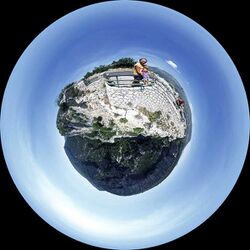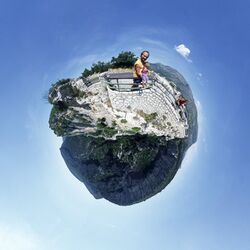Unusual remappings
The possibilities of panotools go far beyond mere panorama stitching. Due to its flexibility and modular design there are some remappings possible that (may be) were not intended originally. It is possible to perform these (and other unusual) remappings using the Panorama Tools Plugins. There is a Photoshop action by Flemming V. Larsen which uses the plugins: [1].
I prefer to use one of the GUI front-ends, since they allow for a more convenient control. Here are steps for PTGui and hugin but it should be possible with PTAssembler or PTMac in a similar way.
Little planet
This is a remapping already used by Helmut Dersch as a thumbnail for his virtual Marburg tour on [2], where he remapped an equirectangular full spherical panorama to a 360 degree fisheye image with the nadir in the center and the zenith at the circle border. This is the same projection as used in the first example.
Nowadays most GUI front-ends feature stereographic and fisheye output projection directly. Stereographic is far better for Little Planets since the outer regions are less compressed and hence keep their natural proportions. The stereographic example here has a smaller Field of View (250°) although the apparent size of the planet is approximately the same like the fisheye one.
Some Panorama Viewers like f.e. KRPano or DevalVR also feature stereographic projection or even "Little Planet" directly.
Tweaks
If you don't like the rotation of the result image you use Numerical transform from the PTGui panorama editor (Ctrl+E). Enter a step value for Roll (f.e. -10) and press Apply button repeatedly until you like the rotation.
You can change "Little planet" to "Tunnel view" (same projection with the zenith in the center and the nadir on the outer side) if you put -90 in the Pitch field on Image tab in order to view straight up.
Orientation plate (arc)
On some places with wide panoramic vistas you can find orientation plates. Arc formed prints of the panorama. Panotools can make this remapping from a cylindrical panorama to an arc formed one, too. No need to edit scripts here but a pocket calculator might be of some use and you should know the approximate horizontal Field of View (here abbreviated as hFoV) of your panorama. This works even for 360 degree panoramas.
Steps
PTGui
- Open PTGui, choose Advanced mode and load your cylindrical image on Source Images tab page. Eventually press Cancel for both EXIF related dialogs.
- On Lens Settings tab:
- choose Cylindrical from the Lens type list
- set Horizontal Field of View to the field of view of your panorama
- click Reset under Lens correction in order to set all lens correction parameters to 0.0
- In Panorama Editor (Ctrl+E):
- choose Little Planet from the Projection menu. (Optionally you can exaggerate the height inside the arc using the Compression slider in the Projection side bar.)
- adjust panorama width and height using the sliders such that it contains the whole arc. The result image will likely be above the middle.
- drag a yellow crop line from the bottom edge of the canvas to get rid of empty space.
- On Create Panorama tab:
- set the width and file format you want for your output image. One single image is created hence any single image format is good. Don't forget the image name.
- check the output size and click Create panorama.
If you need the older version of this page, which contained several formulas, please go to [3]
Hugin
- Open Hugin, choose Interface>Advanced and load you cylindrical image.
- In the Photos tab choose Cylindrical as Lens type, double click on the image and set degrees of view on the Lens tab to the field of view of your panorama and pitch to 90. Close dialog with Ok.
- Now open the preview window, select output projection on the projection tab as Stereographic and adjust width and height with the sliders. Use the crop tab to get rid of the empty borders.
- Go to the Assistant tab and select Stitch. Adjust the output size in pixel if needed and remap the orientation plate.


